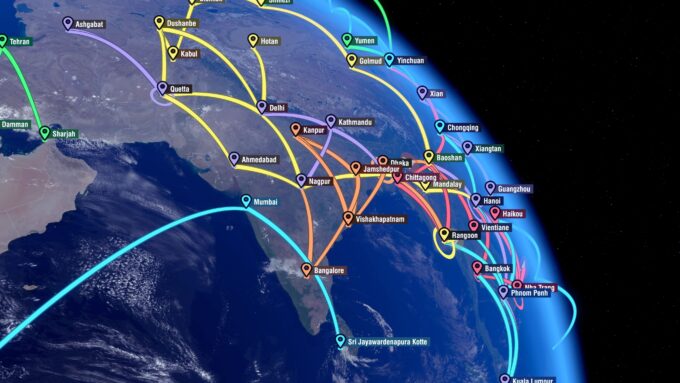
Carbon accounting: learnings from the governance journey
How companies understand their sustainability-related governance may hold the key to meeting climate goals and thriving in a net-zero economy ...

by Carlos Cordon Published 4 October 2023 in Supply chain • 5 min read
A paradigm shift is underway as multinational companies revamp their supply chain strategies to mitigate risks and ensure business continuity. The traditional approach of offshoring operations to low-cost destinations is giving way to a more regional or even localized approach.
This transformation – driven by a combination of factors including geopolitical developments, sustainability concerns, and the need to adapt quickly to changing consumer preferences – is reshaping the way businesses operate on a global scale.
One prime example of this is Inditex, the global fashion group that operates renowned brands like Zara. For decades, the company has produced garments across a network of factories in Spain, Portugal, Turkey, and Morocco, allowing for rapid adaptation to evolving consumer tastes in Europe. It also enabled them to avoid the worst effects of many disruptions in recent years. Furthermore, multinational companies are also investing heavily in Mexico to establish regional production bases to maintain their sales to the North American market.
However, while the benefits of this transformation are evident, not all industries can seamlessly restructure their supply chains due to challenges related to the accessibility of components or resources.
The food supply chain is a case in point, as it includes various levels of localization and globalization. Certain food products, due to their perishable nature, are best suited for local or regional production. In contrast, commodities like coffee, spices, and exotic fruits often originate from distant regions to meet specific climate requirements.
Nevertheless, industries that once heavily relied on globalized supply chains are now shifting towards a regional focus, except in cases where businesses have no alternative but to maintain a global presence. The growing trend is driven in part by reduced access to critical resources caused by geopolitical tensions and trade barriers.
A striking example is the scramble by Chinese internet giants such as Tencent and ByteDance to amass American-made, high-performance computer chips for building generative artificial intelligence systems, driven by fears of potential US export restrictions amid escalating trade conflicts with Beijing.
In response to these concerns, global chip manufacturer TSMC has restructured its operations from heavy reliance on its Taiwanese manufacturing base to the creation of regional production hubs, including a new €10 billion plant in Germany. This strategic pivot is a direct response to concerns voiced by governments and customers worldwide over the potential for conflict between Taiwan and China.
The second factor driving regionalized supply chains is sustainability. As companies face mounting pressure to reduce Scope 3 (indirect) emissions, evaluating the environmental, social, and governance (ESG) credentials of suppliers has become crucial.

Companies like Nestlé, the world’s largest food company, are grappling with assessing thousands of suppliers to ensure compliance. Additionally, legal accountability for suppliers’ actions, such as Germany’s imposition of fines for human rights violations, further underscores the urgency.
Multinational companies are also seeking to cut risk in their supply chains and reduce overreliance on any one regional location, particularly China. Companies are adopting “China plus one” strategies, diversifying their supply chains to locations like India and Vietnam to mitigate disruptions stemming from COVID-related challenges and geopolitical tensions.
This growing trend has become known as “de-risking”, indicating a move towards enhancing supply chain resilience, rather than a complete detachment from China, known as “decoupling”.
Foxconn’s recent expansion in India exemplifies the trend. Although the iPhone supplier first invested in India 15 years ago, it’s undergoing a renewed push into the country. It has acquired land near Bengaluru to bolster its existing portfolio of 36 factories on the subcontinent. While Foxconn is headquartered in Taiwan, most of its revenue comes from its operations in China – traditionally known as the world’s factory owing partly to its sizable and cost-effective labor force.
Methods to achieve de-risking encompass three main strategies.
Vertical integration is where a company controls multiple stages of production and distribution by acquiring businesses positioned at different points along the supply chain. Apple’s recent efforts to develop its own wireless communications chips, replacing those currently manufactured by Broadcom and Qualcomm, and to make its own displays, exemplify this approach.
Vertical integration enables companies to mitigate risks related to supply chain disruptions or changes in market conditions. It also helps firms extract value from their supply chains. However, it’s worth noting that this can be complex and resource intensive. Also, if it limits competition, vertical integration could raise concerns about antitrust or monopolistic behavior.

Consolidating intermediaries is another strategy, improving traceability and control. In the coffee industry, there could be over a dozen intermediaries from bean to cup, making it a huge organizational challenge to monitor the various players at each stage of production and distribution. There are also major reputational risks for companies whose suppliers are caught up in wrongdoing, underscoring the importance of better due diligence for suppliers. Several companies are now taking proactive steps to reduce the number of links in the coffee supply chain to better manage those risks.
Also, regular audits and assessments will help evaluate their practices. Collaboration with suppliers to address sustainability challenges and offering training, meanwhile, can lead to continuous improvement. Apple, for one, offers capacity-building programs to help suppliers become more sustainable. This could include workshops or webinars on best practices.
Furthermore, closely monitoring geopolitical developments is crucial for timely identification of potential risks. Geopolitical tensions, trade disputes, and regulatory changes can significantly disrupt global supply chains, as evidenced by the ongoing US-China trade conflict. By staying informed about geopolitical developments, companies can anticipate potential risks and implement contingency plans to minimize disruptions.
Nevertheless, de-risking measures come with trade-offs. While they enhance supply chain resilience, they can increase costs and complexity. For example, maintaining larger inventories to buffer against disruptions ties up capital and increases storage costs, and implementing strategies like diversifying suppliers or maintaining larger inventories requires careful evaluation of cost-benefit ratios.
Ultimately, de-risking strategies, sustainability considerations, and geopolitical awareness will play pivotal roles in reshaping how businesses operate and ensure long-term viability in the years ahead.

Professor of Strategy and Supply Chain Management
Carlos Cordon is a Professor of Strategy and Supply Chain Management. Professor Cordon’s areas of interest are digital value chains, supply and demand chain management, digital lean, and process management.

16 November 2023 • by Ralf W. Seifert, Richard Markoff, Alexander Schmidt in Supply chain
How companies understand their sustainability-related governance may hold the key to meeting climate goals and thriving in a net-zero economy ...

14 November 2023 in Supply chain
Henrik Andersen discusses with IMD President Jean-François Manzoni the challenges of navigating supply chain disruptions and soaring raw material costs over the past three years, and why he changed the wind farm...

7 November 2023 • by Mark J. Greeven, Patrick Reinmoeller in Supply chain
Li Shufu, CEO and founder of Chinese carmaker Geely, overcame a host of setbacks to become the billionaire owner of a multi-faceted business ...

25 September 2023 • by Ralf W. Seifert, Richard Markoff in Supply chain
At a supply chain software vendor event this summer in the United States, the CSCO of a major fast-moving consumer goods company declared, almost as an aside, that his company was in...
Explore first person business intelligence from top minds curated for a global executive audience